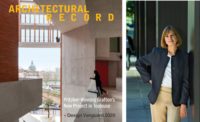A reader wrote RECORD last year arguing that architecture is a political-free zone, and that any discussion that touched on politics didn’t belong in this magazine. We can agree to disagree on that—broadly, politics is about the public interest, and that is where architecture almost always resides.
But in the past month, we have seen the politicization of architecture to an extent that few of us imagined possible. RECORD first broke the story that a proposed executive order (EO) was circulating in the White House that would dictate that “the classical architectural style shall be the preferred and default style” for most new and upgraded federal buildings. The response from the media, architects, and professional organizations was immediate, with most of the outcry against any top-down prescription of “style” for government buildings. The objections came from some surprising corners. For example, Michael Lykoudis, FAIA, dean of University of Notre Dame’s architecture school, which emphasizes classical architecture and traditional urbanism, expressed dismay in the Washington Post at the proposed order: “Classical architecture is not a style,” he wrote. “It is a dedication to principles of community, resilience, and beauty.” Read more about reactions across the profession. (As RECORD went to press, the proposed EO had not been issued.)
The narrow interpretation of “classical” as a style is just one serious problem with the proposed EO, no matter what your predilections in architecture may be.
First, the “master mind” behind the EO seems to be a single organization. As RECORD reported in our original story, the president of the National Civic Art Society, Justin Shubow (who is not an architect or historian but seems to have the ear of the White House) was Trump’s first appointment to the U.S. Commission of Fine Arts, which reviews new architecture in Washington, D.C. Now another Trump appointment to the commission sits on the Society’s board. And the mechanism for approving new federal architecture nationwide, put forth in the draft EO, would be a committee including one member from the commission as designated by the president.
In addition, the language and rationale of the EO both echo the Society’s website—which decries contemporary architecture as “by and large a failure”—and reads as a summary of “Why America Needs Classical Architecture,” a recent article in City Journal by Catesby Leigh, who was the 2018–19 research fellow of the Society.
Second, the EO draft, while sharply critical of modernist, Brutalist and Deconstructivist architecture, pays little or no attention to the myriad, complex factors that architects actually address beyond designing the facades of public buildings—the program, the users, the community, the urban context, the creation of public space, innovation in materials and systems, construction details, efficiencies and budgets, as well as the quality of interior spaces. The document doesn’t seem to have been written or even vetted by a working architect.
Third, the EO proposal ignores the single most important issue confronting architects today: how to help combat the climate crisis. But for an administration that in recent months has rolled back regulations protecting streams and rivers, air quality, and the protection of endangered species and public lands, this is no surprise.
Yet sustainability is the leading concern of young architects today—those who will be designing and building our future.
In this issue of RECORD, and in subsequent issues, we are zeroing in on how architects are taking action for a sustainable future—from SOM, the pioneers of glass and steel towers now exploring timber to the passive strategies a team has employed in an unusual government building in India. And, as senior editor Joann Gonchar, FAIA, details in “Carbon Crackdown”, today’s sophisticated tactics and tools are taking sustainable architecture far beyond energy savings.
People may not agree on what makes great architecture, but we do know that what is most important are high standards of quality and sensitivity to people and the places where we build. We need to look forward, not back, and use technology to make buildings that perform better and address the needs of today’s world.




